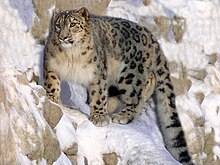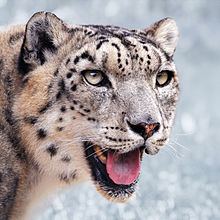Snow leopard (aka irbis) is a large cat of smoky brownish-gray color with pattern of large spots. Weight — 26-40 kg. Snow leopard is silent. Only occasionally you can hear his bassy grunt. It is believed that the limit of life of snow leopards is 15-18 years. The native land of the snow leopard is the mountains of Central Asia — from the Himalayas to the Altai and from the Tien Shan to the Hindikush and East Tibet. In ancient times, snow leopards were tamed and hunted with mountain goats. Now the snow leopard in Kazakhstan and all over the world is on the verge of extinction. It is listed in the Red Book
И́рбис, или сне́жный барс, или снежный леопард — крупное хищное млекопитающее семейства кошачьих, обитающее в горах Центральной Азии.
Ирбис отличается тонким, длинным, гибким телом, относительно короткими лапами, небольшой головой и очень длинным хвостом. Достигая вместе с хвостом длины 200—230 см, весит до 55 кг. Окраска меха светлая дымчато-серая с кольцеобразными и сплошными тёмными пятнами.
В силу труднодоступности местообитания и низкой плотности вида до сих пор остаются малоисследованными многие аспекты его биологии.
Snow leopard, or irbis is listed in the Red book as «endangered»
IRBIS belongs to poorly studied species. The habitat of the snow leopard includes parts of the territories of 13 States: Afghanistan, Burma, Bhutan, India, Kazakhstan, Kyrgyzstan, China, Mongolia, Nepal, Pakistan, Russia, Tajikistan, Uzbekistan. Among big cats the snow leopard is the only permanent inhabitant of the highlands, and represents the majestic, mysterious and harsh world of the mountains of Central Asia. The survival of this rare cat in severely disturbed and degrading mountain ecosystems is extremely difficult or even impossible, so the preservation of viable populations of the snow leopard is inevitably associated with effective protection of its habitat as a whole. Also in the mountains there is an active poaching and hunting for the skins of these beautiful animals.
Снежный барс, или ирбис занесен в Красную книгу как «находящийся под угрозой исчезновения».
Ирбис принадлежит к слабо изученным видам.Место обитания ирбиса включают в себя части территорий 13 государств: Афганистана, Бирмы, Бутана, Индии, Казахстана, Киргизстана, Китая, Монголии, Непала, Пакистана, России, Таджикистана, Узбекистана. Среди крупных кошачьих ирбис — единственный постоянный обитатель высокогорий, олицетворяет собой величественный, загадочный и суровый мир гор Центральной Азии. Выживание этой редкой кошки в сильно нарушенных и пришедших в упадок горных экосистемах крайне затруднительно или невозможно, соответственно сохранение жизнеспособных популяций ирбиса неизбежно сопряжено с эффективной охраной среды его обитания в целом.Также в горах идет активное браконьерство и охота за шкурами этих прекрасных животных.
In the Himalaya mountains lives a Snow leopard . It is also called IRBIS. He is considered the king of the neighborhood . Snow leopard is not very big , its weight does not exceed forty pounds , height IRBIS zero point and six-tenths meters length and one and three-tenths meters. Leopard like a leopard, but its color is smoky — gray , with dark rings . The fur is thick, fluffy, one on the tail. And he climbs the mountain slopes to a height of five thousand meters.
Once in the mountains of the Himalayas, Snow leopards lived with his mother. Once mom went on the hunt and the snow leopard remained in the home. The mother began to chase the Groundhog to feed the little boy. But suddenly from somewhere appeared two hunters. When the hunters saw a mother snow leopard, they both looked at each — other. And shot her. Mother leopard fled until then, until it ran out of power. The little snow leopard was waiting for his mother, but she did not. The case has been in the evening. Without waiting for her mother, a Snow leopard out of the home, see where she is. IRBIS has never went hunting. The hunters knew that the mother leopard lived here not one. They decided that like could wait and maybe someone will find it. IRBIS walked, but no production could not find. The hunters saw this little snow leopard and began to shoot him. But he ran away from them and escaped, but the hunters shot him in the leg. Bars could no longer run and fell, because he had no strength. But he was approached by a man . IRBIS thought he wanted to kill him, he wanted to flee , to escape , but could not. This man saw that the IRBIS wounded paw. He gently took it and carried home .In the house of the man who brought Barca, it was very warm. Hunter bandaged his leg and fed. And IRBIS immediately fell asleep near the stove.
The time has passed . IRBIS grew up , became healthy . Then the man released him in the mountains . In the mountains of leopards he met his soul mate , and they had offspring . IRBIS was a good father and a hunter. Here such history happened with the Snow leopard.
From Simple English Wikipedia, the free encyclopedia
| Snow leopard | |
|---|---|

|
|
|
Conservation status |
|
|
|
|
| Scientific classification |
|
| Kingdom: | Animalia |
| Phylum: | Chordata |
| Class: | Mammalia |
| Order: | Carnivora |
| Suborder: | Feliformia |
| Family: | Felidae |
| Subfamily: | Pantherinae |
| Genus: | Panthera |
| Species: |
P. uncia |
| Binomial name | |
| Panthera uncia
(Schreber, 1775) |
|
| Subspecies | |
|
|

|
|
| Distribution of snow leopard, 2017[1] | |
| Synonyms | |
|
The snow leopard (Panthera uncia), also known as the Irbis and ounce, is a feline, which lives in central Asia. It used to be thought not to be closely related to the smaller leopard, which is why they were put in different genera before. However, recent research has discovered this is not correct. The cat is closely related to the other big cats in the genus Panthera.
Appearance[change | change source]
Snow leopards are about 2-5 meters long in the body, and have a 90-100 centimeter long tail. They weigh up to 75 kilograms. They have grey and white fur with dark rosettes and spots, and their tails have stripes. Its fur is very long and thick to protect it against the cold. Their feet are also big and furry, which helps them to walk on snow more easily. They use their long tails for balance and as blankets to cover sensitive body parts against the severe mountain chill.
Voice[change | change source]
They are one of the cats which cannot purr: «In five cat species (lion, tiger, jaguar, leopard and snow leopard) the epihyoideum is an elastic ligament, whereas in all other species of the Felidae the epihyal is completely ossified (bony)… those felids with an elastic epihyoid are able to roar but not purr, while species with a completely ossified hyoid are able to purr but not to roar».[2] Despite this, it seems now that snow leopards cannot roar, though they can make a number of other sounds.[2]
Hunting[change | change source]
Snow leopards are well camouflaged, and are crepuscular (most active at dawn and dusk). They stalk and eat medium-sized prey like Ibex, bharal (mountain sheep) and wild goats. It can survive on a single sheep for two weeks.
Snow leopards prefer to ambush prey from above, using broken terrain to conceal their approach. They try to land on the sheep, and kill it directly. If the sheep runs, they pursue it down steep mountainsides, using the momentum of their initial leap to chase prey for up to 300 m (980 ft).
They kill with a bite to the neck, and may drag the prey to a safe location before feeding. They consume all edible parts of the carcass, and can survive on a single bharal (blue sheep) for two weeks before hunting again. Annual prey needs is 20–30 adult bharals.[3]
Habitats[change | change source]
In summer, snow leopards usually live above the tree line on mountainous meadows and in rocky regions at altitudes from 2,700 to 6,550 m (8,860 to 21,490 ft). In winter, they come down into the forests to altitudes around 1,200 to 2,000 m (3,900 to 6,600 ft). Snow leopards prefer broken terrain, and can travel without difficulty in snow up to 85 cm (33 in) deep, although they prefer to use existing trails made by other animals.[4]
They live alone. After a pregnancy of about a hundred days the female gives birth to 2 or 3 cubs. Snow leopards are protected in most of the countries they live in. However, people do still kill them for their fur, or to protect their cattle.
Distribution[change | change source]
The snow leopard has a huge range in central Asia.[5][6] It is in Afghanistan, Bhutan, China, India, Kazakhstan, Kyrgyzstan, Nepal, Pakistan, Russia, Tajikistan, Uzbekistan, Kashmir, Kunlun, and the Himalaya to southern Siberia, Mongolia, and Tibet.[3][7]
Since many estimates are rough and outdated, its numbers could be falsely viewed as low. The total wild population of the snow leopard was estimated in 2008 as 4,510 to 7,350 individuals.[1][3]
Taxonomy and evolution[change | change source]
The snow leopard was not thought closely related to the Panthera or other living big cats. However, recent molecular studies put the species firmly in the genus Panthera: its closest relative is the tiger (Panthera tigris).[3][8] MSW3 still refers to the snow leopard as Uncia uncia, but the more recent IUCN classifies it as Panthera uncia.[3][9]
In popular culture[change | change source]
The snow leopard is an official symbol of Kazakhstan.[10]
References[change | change source]
- ↑ 1.0 1.1 1.2 McCarthy, T.; Mallon, D.; Jackson, R.; Zahler, P. & McCarthy, K. (2017). «Panthera uncia». IUCN Red List of Threatened Species. 2017: e.T22732A50664030.
- ↑ 2.0 2.1 Weissengruber G.E.; et al. (2002). «Hyoid apparatus and pharynx in the lion (Panthera leo), jaguar (Panthera onca), tiger (Panthera tigris), cheetah (Acinonyx jubatus) and domestic cat (Felis silvestris f. catus)». Journal of Anatomy. 201 (3): 195–209. doi:10.1046/j.1469-7580.2002.00088.x. PMC 1570911. PMID 12363272.
- ↑ 3.0 3.1 3.2 3.3 3.4 Panthera uncia (Ounce, Snow Leopard). Iucnredlist.org. Retrieved 2012-08-23.
- ↑ Sunquist, Mel & Sunquist, Fiona 2002. Wild cats of the world. Chicago: University of Chicago Press, 377–394. ISBN 0-226-77999-8
- ↑ A map of the snow leopard’s range. Snowleopardconservancy.org. Retrieved 2013-06-03.
- ↑ «Out of the shadows by Douglas H. Chadwick». National Geographic. 2008. Retrieved 2010-01-29.
- ↑ Geptner, Vladimir G.; et al. (1992). Mammals of the Soviet Union: Carnivora. BRILL. ISBN 978-90-04-08876-4.
- ↑ Davis, B. W.; Li, G. & Murphy, W. J. (2010). «Supermatrix and species tree methods resolve phylogenetic relationships within the big cats, Panthera (Carnivora: Felidae)». Molecular Phylogenetics and Evolution. 56 (1): 64–76. doi:10.1016/j.ympev.2010.01.036. PMID 20138224.
- ↑ Johnson W.E.; et al. (2006). «The late Miocene radiation of modern Felidae: a genetic assessment». Science. 311 (5757): 73–77. Bibcode:2006Sci…311…73J. doi:10.1126/science.1122277. PMID 16400146. S2CID 41672825.
- ↑ «Global Snow Leopard & Ecosystem Protection Program». Archived from the original on 2019-10-20. Retrieved 2019-10-20.


